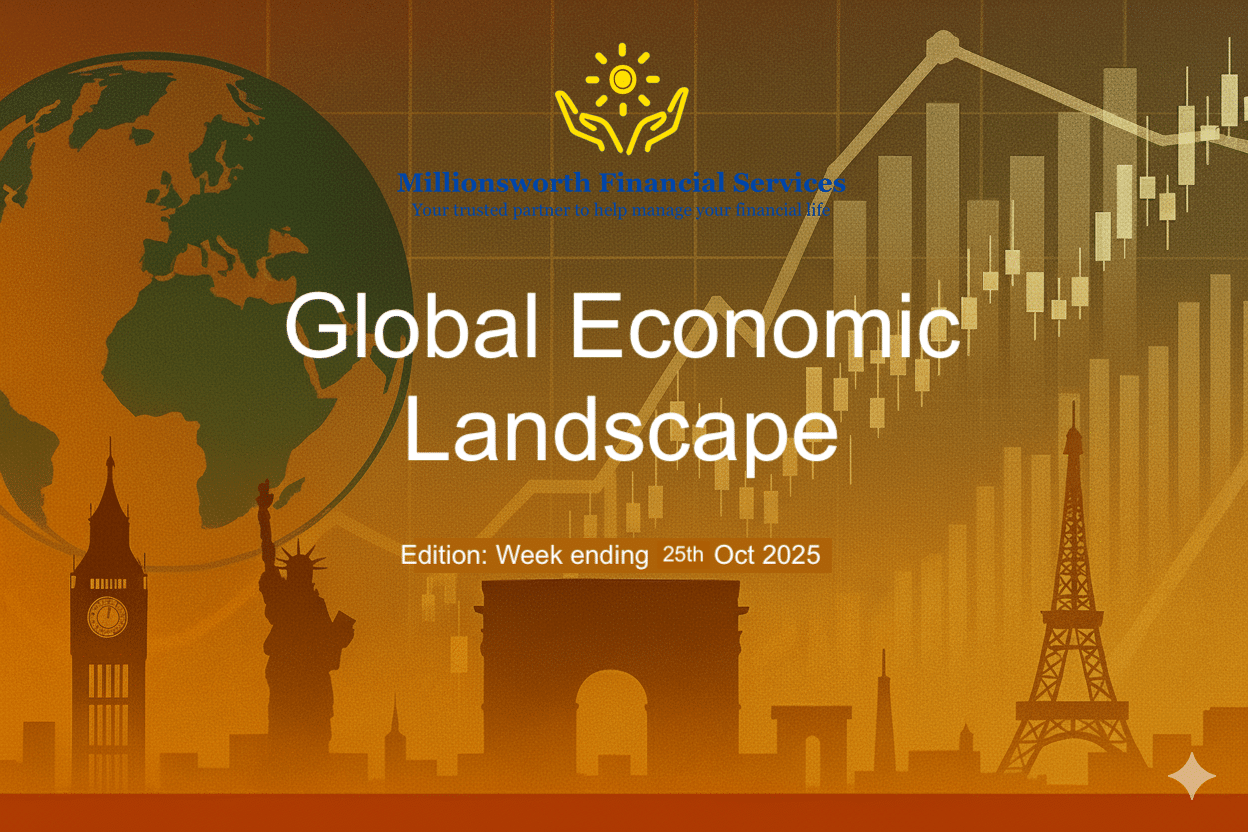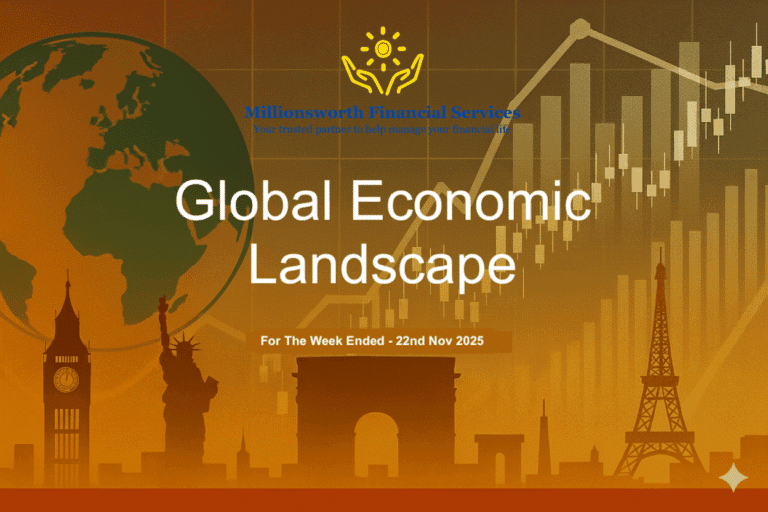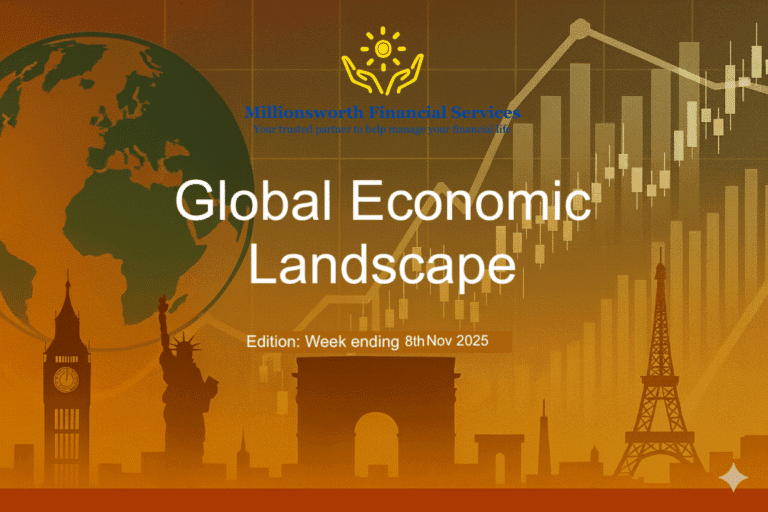The global economic landscape entered the final stretch of October with a blend of optimism and caution. Policy support and resilient data from major economies suggest that growth, though uneven, remains intact. India’s fiscal and reform momentum, the United States’ “Goldilocks” mix of steady expansion and easing inflation, and Europe’s manufacturing revival point toward sustained activity. Meanwhile, China and Japan continue to navigate their own rebalancing paths — China leaning on industry and exports, and Japan on currency-driven competitiveness. For investors, one theme stands out: selectivity. In a changing global economic landscape, opportunities exist, but rewards depend increasingly on identifying the right sectors, geographies, and durations rather than broad market exposure.
India: Fiscal Push Meets Selective Opportunity
India’s macro environment continues to balance optimism with caution. The government’s strong fiscal momentum — highlighted by ₹79,000 crore in defence procurement and renewed infrastructure spending — alongside reforms in mining and energy, reflects its commitment to sustaining growth. Corporate profits remain robust (₹7.1 trillion in FY25), and foreign inflows into the financial sector (₹50,000 crore) signal global confidence in India’s long-term story.
However, short-term data show moderation: infrastructure output slowed to 3% (from 6.5%), and sector-specific challenges emerged in steel (import competition) and leather (U.S. tariffs). The RBI’s mention of rising geopolitical risks underscores the need for vigilance.
Investor Insights:
- Equities: Government-led spending and strong foreign inflows create clear opportunities in defence, infrastructure, and financials. This remains a stock-picker’s market, not an index play.
- Debt: With stable call money rates, monetary conditions are steady. However, import pressures and geopolitical risks favour shorter-duration, high-quality bonds.
- Commodities: Gold’s 3.3% decline after record highs is a healthy correction, not a reversal. The RBI’s continued gold accumulation and expectations of global rate cuts reinforce a long-term bullish case for gold and silver.
United States: The “Goldilocks” Quarter Begins
The U.S. economy entered Q4 on solid footing. The Flash Composite PMI surged to 54.8 — a three-month high — driven by strength in manufacturing and services. Housing also recovered, with existing home sales up 1.5% as mortgage rates dropped to 6.19%. Crucially, inflation cooled, with both headline and core CPI at 3.0%, easing pressure on the Federal Reserve after its recent rate cuts.
Investor Insights:
- Equities: A classic “Goldilocks” environment — steady growth and moderating inflation — supports growth, technology, and housing-related sectors.
- Debt: Disinflation expectations point to continued Fed rate cuts and a bull-steepening yield curve, making this a favourable time to lock into longer-duration bonds.
- Commodities: Falling real rates and a softer dollar sustain bullish momentum for gold and silver, reinforcing their role as safe-haven assets.
UK & Eurozone: Resilience Amid Sticky Inflation
Economic data from the UK and Eurozone surprised positively. The UK’s Flash PMI rose to 51.1, signalling renewed expansion led by manufacturing and retail strength despite weaker business confidence. Inflation remains elevated at 3.8%. In the Eurozone, the Composite PMI climbed to a 17-month high of 52.2, indicating growth traction even as construction output slowed and service-sector price pressures persisted.
Investor Insights:
- Equities: Resilient domestic demand supports UK small-caps and European cyclicals (industrials, financials).
- Debt: Persistent inflation suggests a “higher-for-longer” rate environment, challenging for long-duration bonds.
- Commodities: Stronger manufacturing activity favours industrial metals and energy, while gold and silver may consolidate as real yields remain firm.
China: Selective Strength, Not a Broad Recovery
China’s growth remains uneven. Q3 GDP rose 4.8%, supported by industrial production (+6.5%) and exports, while consumption and property remain soft due to falling home prices and contracting investment. The People’s Bank of China maintained an accommodative stance by keeping the Loan Prime Rate unchanged, aiming to stabilise industry without fuelling financial imbalances.
Investor Insights:
- Equities: Focus on export-oriented and industrial sectors benefiting from Asian demand and pricing power. Avoid property developers and consumer discretionary names until sentiment improves.
- Debt: Low yields and a stable policy stance make high-grade corporate bonds attractive for carry, while property-linked debt remains risky.
- Commodities: Industrial demand underpins silver’s outlook; gold stays neutral-to-bullish amid global uncertainty and accommodative policy.
Japan: Export Tailwinds with Policy Caution
Japan’s exports rebounded (+4.2% YoY in September), aided by yen weakness and Asian demand, though rising imports resulted in a trade deficit of ¥234.6 billion. The Bank of Japan’s tone remains watchful — balancing inflation control with growth stability — hinting at gradual policy normalization.
Investor Insights:
- Equities: The weak yen continues to favour export-driven sectors such as autos, machinery, and semiconductors. Domestic sectors face cost pressures, so focus on companies with pricing power.
- Debt: Any move toward policy normalization could lift long-term yields, favouring short-duration positioning.
- Commodities: Yen depreciation supports local gold prices, while silver benefits from Japan’s manufacturing-led recovery.
Millionsworth : Policy-Driven Growth, Stock-Picker’s Market
The overall tone this week’s Global Economic Landscape remains constructively selective. Fiscal and monetary support continue to drive optimism in India and the U.S., while Europe shows resilience and China and Japan demonstrate targeted recovery. For investors, global growth is policy-supported but uneven — making quality, diversification, and duration discipline key to navigating the months ahead.
Contrarian View: Beware of the Calm
In this week’s Global Economic Landscape, while markets cheer a synchronized soft landing, underlying risks — including geopolitical tensions, trade frictions, and policy fatigue — could trigger swift corrections. The next leg of returns will likely come less from liquidity and more from earnings resilience, valuation discipline, and strategic diversification.



